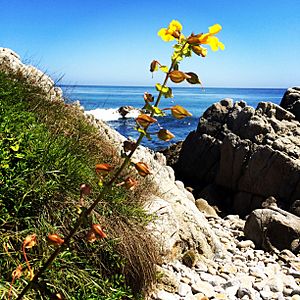Magnificent monkeyflower facts for kids
Quick facts for kids Magnificent monkeyflower |
|
|---|---|
 |
|
| Scientific classification | |
| Genus: |
Erythranthe
|
| Species: |
grandis
|
Erythranthe grandis, also known as the magnificent monkeyflower, is a type of plant. It belongs to the plant family Phrymaceae. This plant is special because it grows along the coast.
Contents
About the Magnificent Monkeyflower
The magnificent monkeyflower is a plant that lives for many years. It grows in coastal areas and is related to another plant called E. guttata.
Before it flowers, especially in winter, it often grows low to the ground. It sends out many side branches called stolons. These help the plant spread out.
This monkeyflower usually blooms from May to August. This is a bit later than other E. guttata plants that grow further inland. Its flower stalks can grow quite long in some places.
The height of these plants changes depending on where they grow. Plants in the northern areas are often short and compact. Those in the south can be much taller.
Leaves and Stems
The leaves of Erythranthe grandis are usually thicker than those of E. guttata. They often look waxy, especially when they are very close to the ocean. The edges of the leaves can be rounded or have small teeth.
Its stems are also thicker than most E. guttata plants and are hollow inside. The green parts that hold the flower, called calyxes, often have tiny hairs. Some of these hairs are sticky, and some are crinkly. In some parts of Northern California and Oregon, these calyxes can even have red spots.
How it's Related to Other Plants
Many scientists used to think of Erythranthe grandis as a special coastal type of Mimulus guttatus. This is because it can easily mix and have babies with other E. guttata plants.
However, recent studies looking at the plant's genes show that E. grandis is different enough to be its own group. Even though it's now seen as a separate species, you can still think of it as a coastal ecotype. An ecotype is a group of plants that has adapted to a specific environment.
E. grandis has also developed a stronger ability to handle salt. This helps it live in salty coastal areas.
Where it Grows
You can find the magnificent monkeyflower along the coast. Its range stretches from southern California all the way up to Cape Disappointment in southern Washington State.
Where it Lives
This plant likes places with a lot of moisture in the soil. You can usually find it in:
- Coastal wet areas
- Cliffs
- Sand dunes
- Marshes
- Roadside ditches
- Headlands (points of land sticking out into the sea)
How it Survives
Erythranthe grandis looks quite different from the E. guttata plants that live for only one year inland. However, some E. guttata plants that live for many years do look similar to E. grandis.
Life Cycle and Adaptations
A big reason for these differences is a special change in their chromosomes. This change helps E. grandis and some perennial E. guttata plants live for many years.
All magnificent monkeyflower plants are perennials. They can live for a long time because of the cool temperatures near the ocean. Also, summer fog along the coast keeps the soil wet. This helps the plants stay hydrated when it's usually dry.
E. grandis also has better ways to protect itself from animals that might eat it. It can also handle more salt than inland E. guttata plants. These strong defenses are likely because coastal areas have more plant-eating animals. Also, salt spray from the ocean lands on the plants, so they need to be tough!

